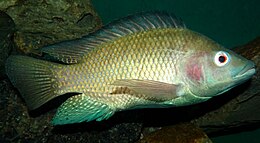
Back بلطي (سمك) Arabic بلطى ARZ Tilapia BCL Тилапия Bulgarian Tilapia Danish Τιλάπια Greek Tilapio EO Tilapia Spanish Tilapia EU تیلاپیا FA
Tilapia (/tɪˈlɑːpiə/ tih-LAH-pee-ə) is the common name for nearly a hundred species of cichlid fish from the coelotilapine, coptodonine, heterotilapine, oreochromine, pelmatolapiine, and tilapiine tribes (formerly all were "Tilapiini"), with the economically most important species placed in the Coptodonini and Oreochromini.[2] Tilapia are mainly freshwater fish inhabiting shallow streams, ponds, rivers, and lakes, and less commonly found living in brackish water. Historically, they have been of major importance in artisanal fishing in Africa, and they are of increasing importance in aquaculture and aquaponics. Tilapia can become a problematic invasive species in new warm-water habitats such as Australia,[3] whether deliberately or accidentally introduced, but generally not in temperate climates due to their inability to survive in cold water.
Traditionally a popular and affordable food in the Philippines with a mild taste, tilapia has been the fourth-most consumed fish in the United States since 2002, favored for its low cost and easy preparation. It is commonly fried or broiled as part of a dish.
- ^ Fisheries and Aquaculture Department Statistics UN Food and Agriculture Department
- ^ Andreas R.Dunz & Ulrich K.Schliewen (2013). "Molecular phylogeny and revised classification of the haplotilapiine cichlid fishes formerly referred to as Tilapia". Molecular Phylogenetics and Evolution. 68 (1): 64–80. doi:10.1016/j.ympev.2013.03.015. PMID 23542002.
- ^ "Tilapia". Department of Agriculture, Fisheries and Forestry. January 2013.

